honors bio final exam me
5.0(1)
Card Sorting
1/169
Earn XP
Description and Tags
Study Analytics
Name | Mastery | Learn | Test | Matching | Spaced |
|---|
No study sessions yet.
170 Terms
1
New cards
proposed scientific explanation for a set of observations hypothesis
hypothesis
2
New cards
numbers, obtained by counting or measuring
quantitative data
3
New cards
description that involves characteristics that can’t be measured (short/tall, color big/small)
qualitative data
4
New cards
steps or procedures scientists use to learn about the natural world
scientific method
5
New cards
a state of balance among all the body systems needed to survive and function correctly
homeostasis
6
New cards
smallest unit of organism considered alive
cell
7
New cards
2 cells from different parent unite to form new, unique cell
sexual reproduction
8
New cards
1 parent cell makes offspring identical to itself
asexual reproduction
9
New cards
organisms can be unicellular or multicellular
made of cells
10
New cards
DNA is tested in a crime scene evidence to determine the source of the blood
based on universal genetic code
11
New cards
blood cells are differentiated from muscles cells
grow and develop
12
New cards
sarah ate three cheeseburgers for lunch
obtain and use energy
13
New cards
plants react to the sun by growing toward the light
respond to environment/stimulus
14
New cards
a person gets goosebumps in a cold theater
maintain a stable internal environment
15
New cards
a frog releases sperm onto a clump of female eggs to produce 500 tadpoles
reproduce
16
New cards
size of horses changed over millions of years
populations evolve
17
New cards
manipulated variable, changed by experimenter
independent variable
18
New cards
responding variable, is observed and changes in response to the experiment
dependent variable
19
New cards
dependent variable is on the x/y axis?
y axis
20
New cards
independent variable is on the x/y axis?
x axis
21
New cards
A. compound light microscopes B. electron microscopes
light pases through 2 lenses to create image, mag. up to 2000x
light pases through 2 lenses to create image, mag. up to 2000x
A.
22
New cards
A. compound light microscopes B. electron microscopes
uses beams of electrons to view images, mag up to 50millionx
uses beams of electrons to view images, mag up to 50millionx
B.
23
New cards
A. compound light microscopes B. electron microscopes
can study both dead and alive organisms
can study both dead and alive organisms
A.
24
New cards
A. compound light microscopes B. electron microscopes
views objects smaller than 0.2 micrometers
views objects smaller than 0.2 micrometers
B.
25
New cards
A. compound light microscopes B. electron microscopes
specimens must be dead
specimens must be dead
B.
26
New cards
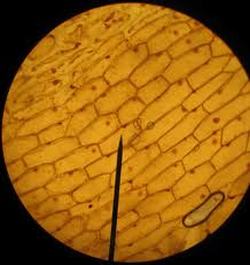
A. compound light microscopes B. electron microscopes
A.
27
New cards
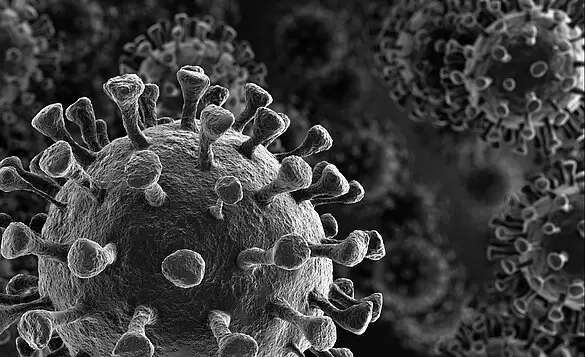
A. compound light microscopes B. electron microscopes
B.
28
New cards
A. compound light microscopes B. electron microscopes
small, less expensive, protable
small, less expensive, protable
A.
29
New cards
A. compound light microscopes B. electron microscopes
large, expensive, not protable
large, expensive, not protable
B.
30
New cards
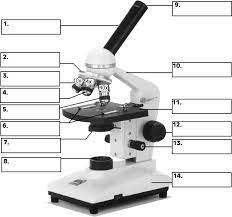
1?
body tube
31
New cards
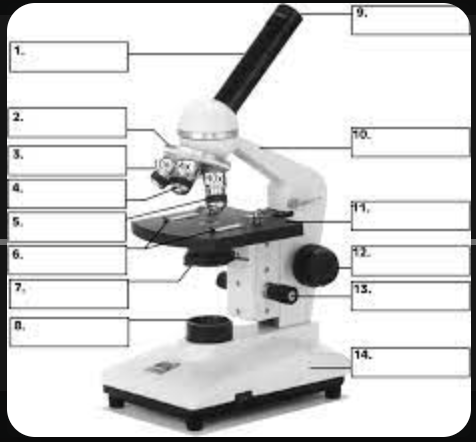
2?
revolving nose piece
32
New cards
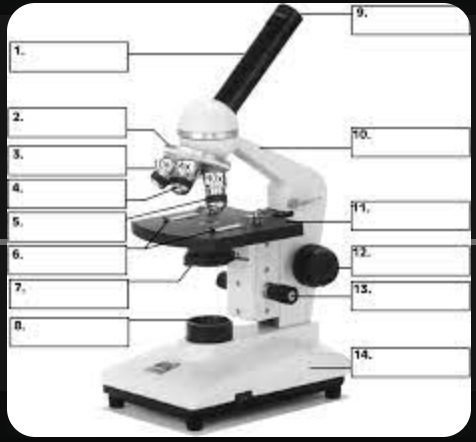
3?
low power objective
33
New cards
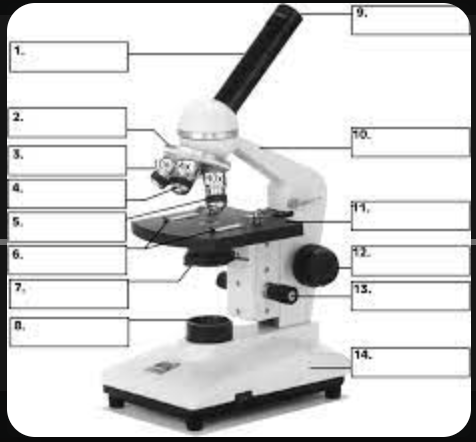
4?
medium power objective
34
New cards

5?
high power objective
35
New cards
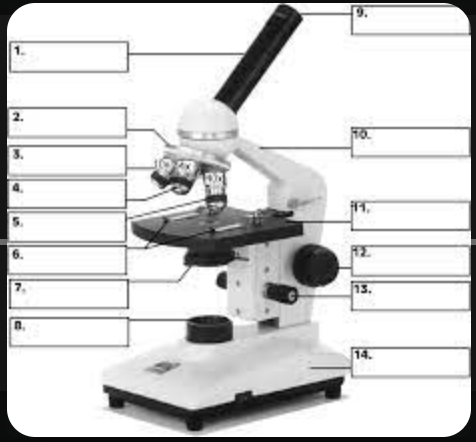
6?
stage clips
36
New cards
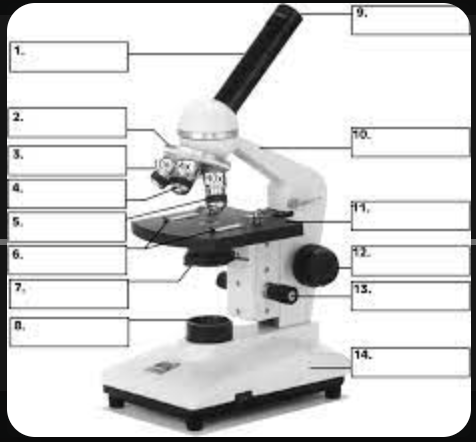
7?
diaphragm
37
New cards
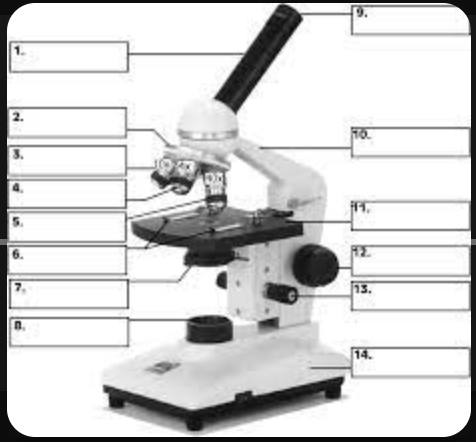
8?
light source
38
New cards
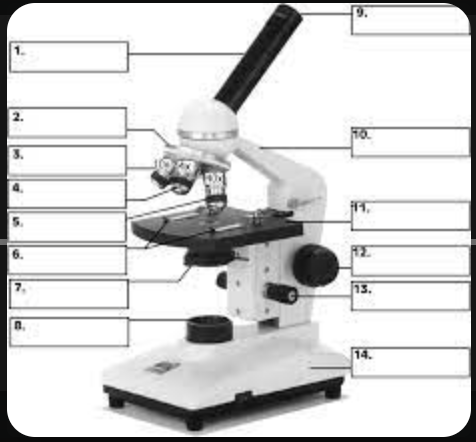
9?
ocular lense
39
New cards

10?
arm
40
New cards
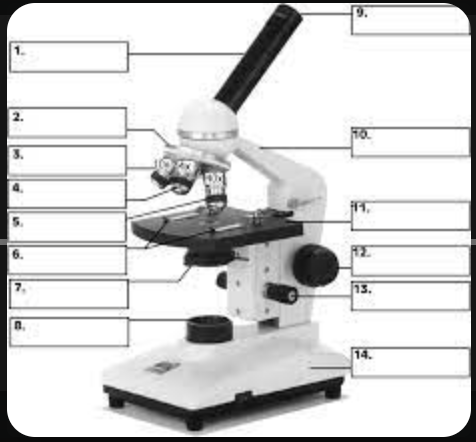
11?
stage
41
New cards

12?
coarse adjustment knob
42
New cards
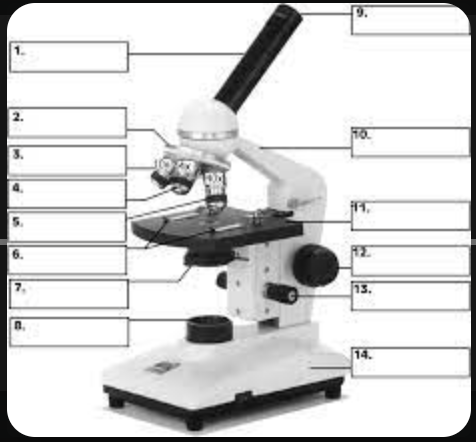
13?
fine adjustment kob
43
New cards
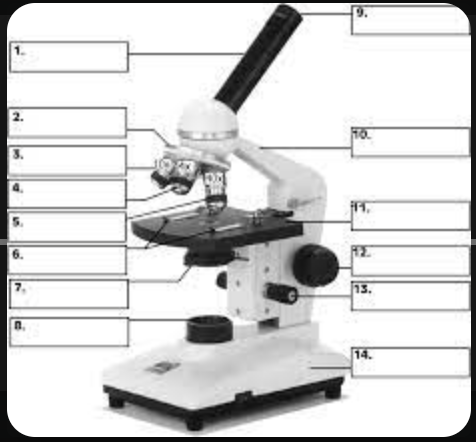
14?
base
44
New cards
nuclei are unstable and break down overtime and give off radiation
isotope
45
New cards
number of protons in nucleus of an atom
atomic number
46
New cards
total number of protons and neutrons in a nucleus
mass number
47
New cards
molecule that gained or lost 1+ electron(s)
ion
48
New cards
properties of compounds different from elements
emergent properties
49
New cards
chemical bond formed when one atom gives up one or more electrons to another atom
ionic bond
50
New cards
chemical bond when electrons are shared by atoms
covalent bond
51
New cards
covalent bond when electron is shared unevenly due to difference in electronegativity
polar
52
New cards
an atom having four covalent bonds b/c of 4 valence electrons
tetravalent
53
New cards
A. lipid B. nucleic acid C. protein D. carbohydrate
main energy source; plants and some animals use for structure
main energy source; plants and some animals use for structure
D.
54
New cards
A. lipid B. nucleic acid C. protein D. carbohydrate
found in food such as starches, fiber, and sugar
found in food such as starches, fiber, and sugar
D.
55
New cards
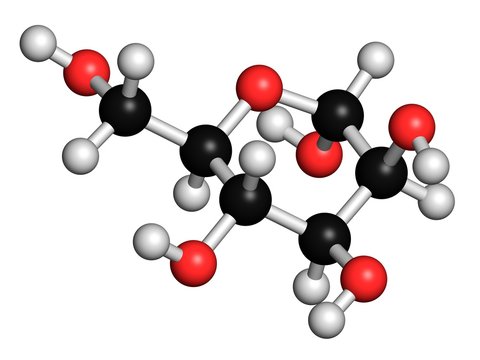
A. lipid B. nucleic acid C. protein D. carbohydrate
what molecule is this?
what molecule is this?
D.
56
New cards
\
A. lipid B. nucleic acid C. protein D. carbohydrate
functions include storing energy, forming membranes, waterproof coverings
A. lipid B. nucleic acid C. protein D. carbohydrate
functions include storing energy, forming membranes, waterproof coverings
A.
57
New cards
A. lipid B. nucleic acid C. protein D. carbohydrate
fats, oils, wax
fats, oils, wax
A.
58
New cards
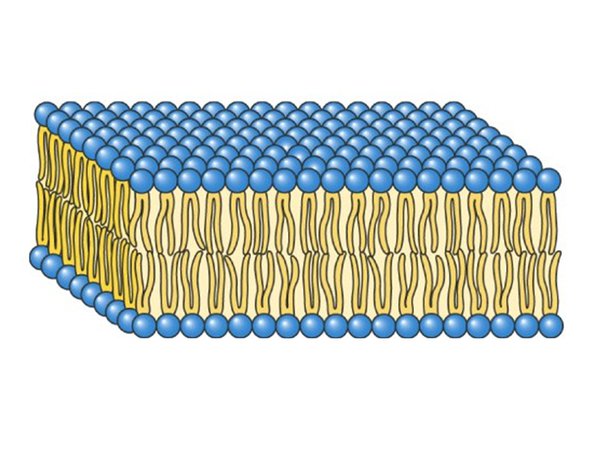
A. lipid B. nucleic acid C. protein D. carbohydrate
what molecule is this?
what molecule is this?
A.
59
New cards
A. lipid B. nucleic acid C. protein D. carbohydrate
functions include, contain genetic or hereditary info, instructions for making proteins
functions include, contain genetic or hereditary info, instructions for making proteins
B.
60
New cards
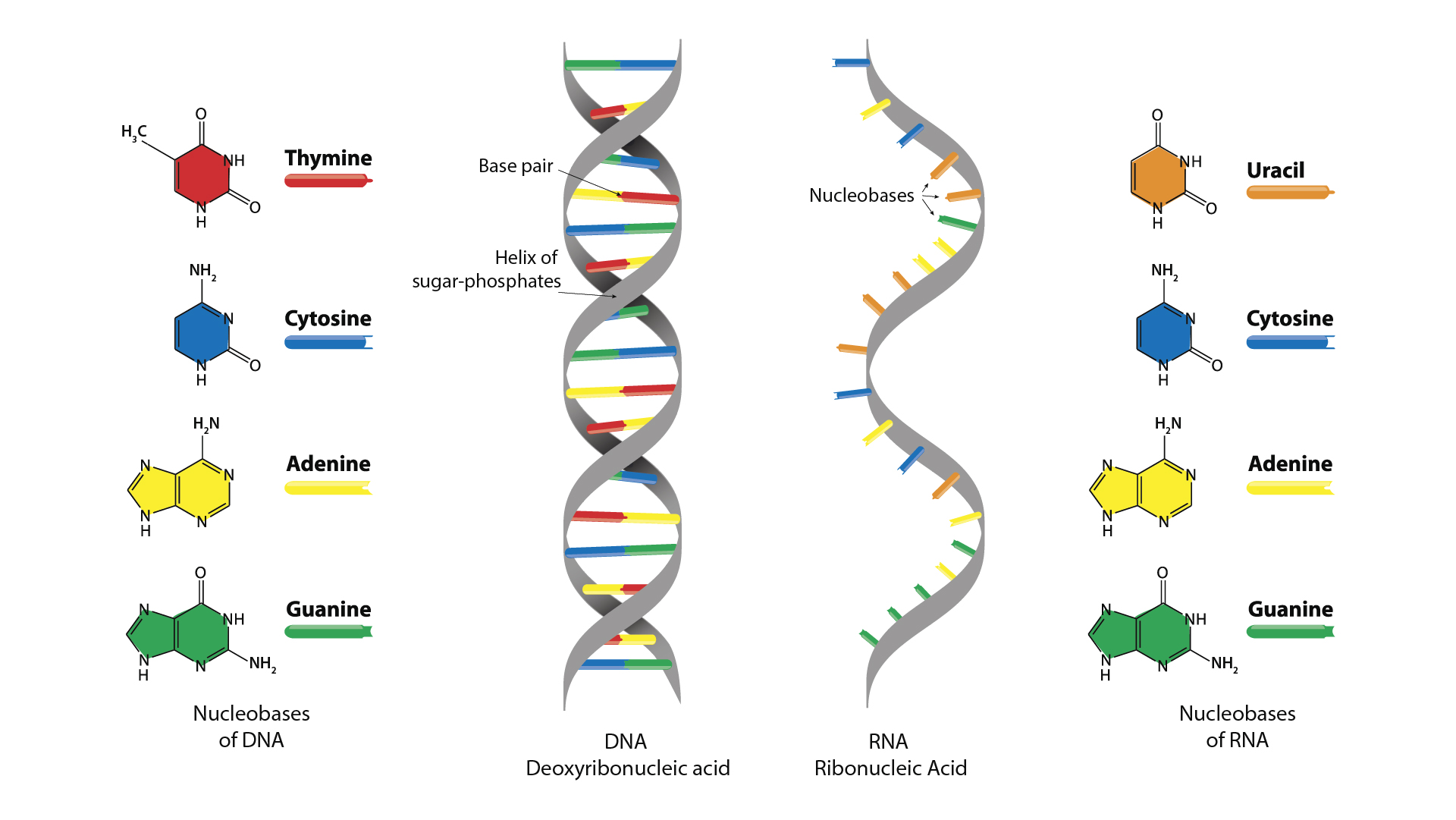
A. lipid B. nucleic acid C. protein D. carbohydrate
what molecule is this?
what molecule is this?
B.
61
New cards
A. lipid B. nucleic acid C. protein D. carbohydrate
functions include, controlling rate of reactions and cell processes, form bones and muscles, transport substances in and out of cells, fight diseases
functions include, controlling rate of reactions and cell processes, form bones and muscles, transport substances in and out of cells, fight diseases
C.
62
New cards
A. lipid B. nucleic acid C. protein D. carbohydrate
has 4 structures
has 4 structures
C .
63
New cards

A. lipid B. nucleic acid C. protein D. carbohydrate
what molecule is this?
what molecule is this?
c.
64
New cards
T/F: cohesion is the attraction between water molecules and different substances?
F
65
New cards
T/F: cohesion is attraction between molecules of same substance
T
66
New cards
T/F: adhesion is attraction between molecules of same substance
F
67
New cards
T/F: adhesion is the attraction between water molecules and different substances?
T
68
New cards
ice floats because it has a higher/lower density than water
lower
69
New cards
T/F: it takes a lot of energy to break hydrogen bonds in water
T
70
New cards
contains ribosomes and makes proteins to be exported by the cell
rough ER
71
New cards
small, dense core of nucleus, makes ribosomes
nucleolus
72
New cards
makes proteins, made of RNA, found in cytoplasm/rough ER
ribosome
73
New cards
capture energy from sunlight and convert it into food, carry out photosynthesis, found in plant and algae ONLY
chloroplast
74
New cards
modifies, sorts, and packages molecules, stack of membranes
golgi apparatus
75
New cards
helps cell maintain shape, form flexible framework, make cilia and flagella
cytoskeleton
76
New cards
convert chemical energy (food) into energy that can be used by the cell (ATP), made of 2 membranes
mitochondria
77
New cards
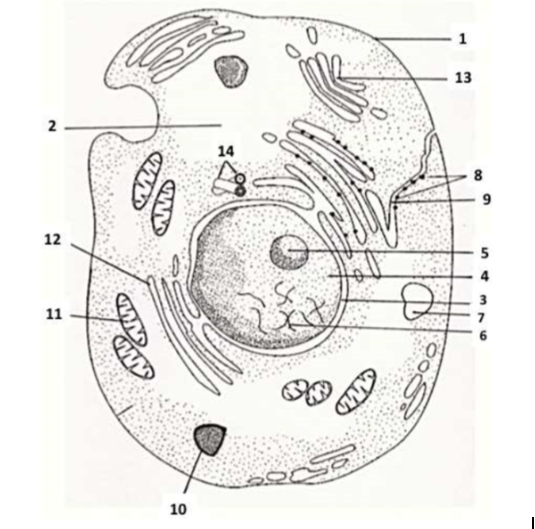
1?
cell wall
78
New cards

2?
cytoplasm
79
New cards
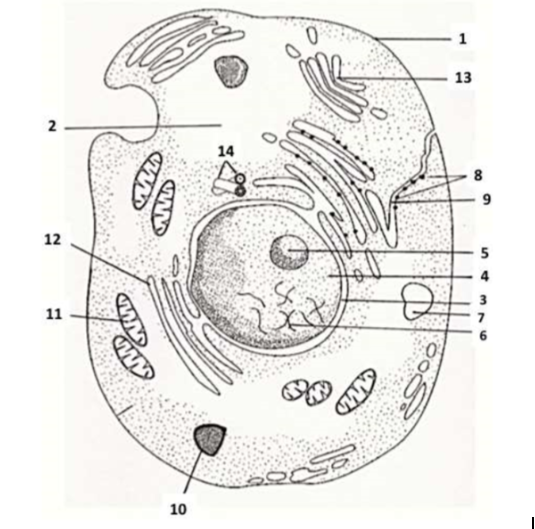
3?
nuclear envlope
80
New cards
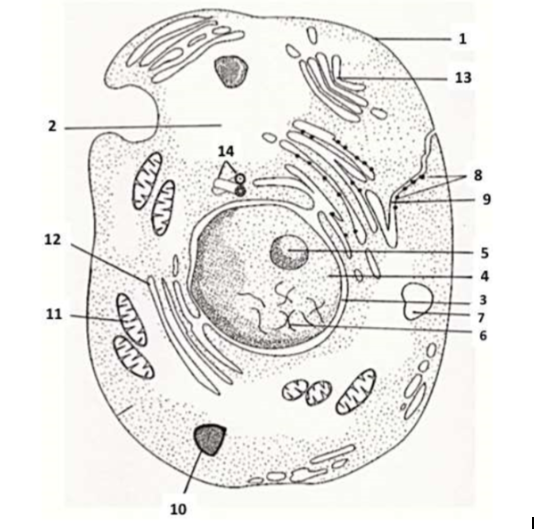
5?
nucleolus
81
New cards
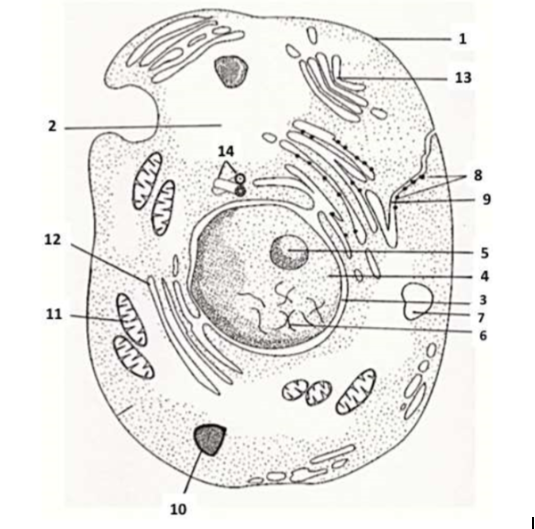
6?
chromatin
82
New cards
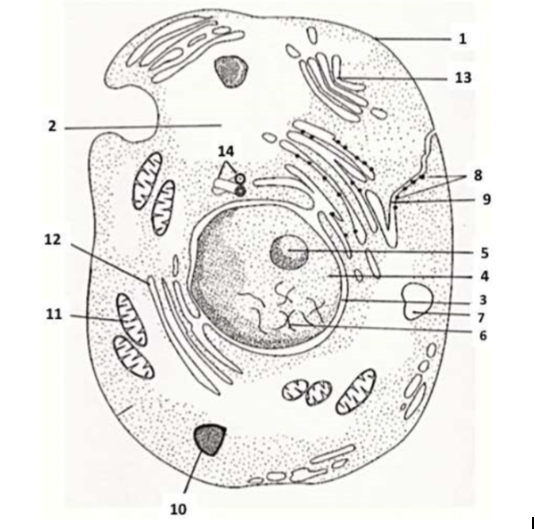
7?
vacule
83
New cards
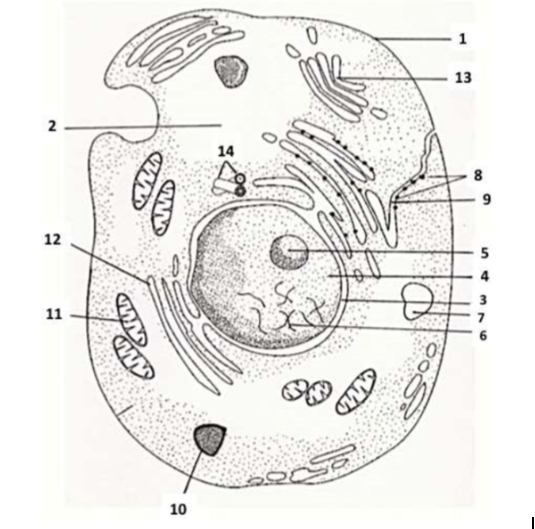
8?
ribosome
84
New cards
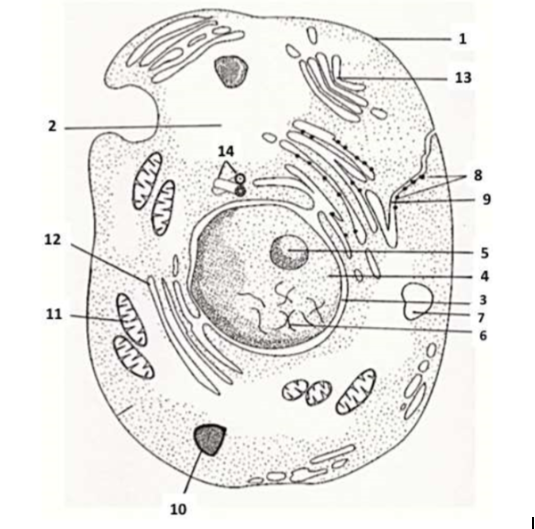
9?
rough ER
85
New cards
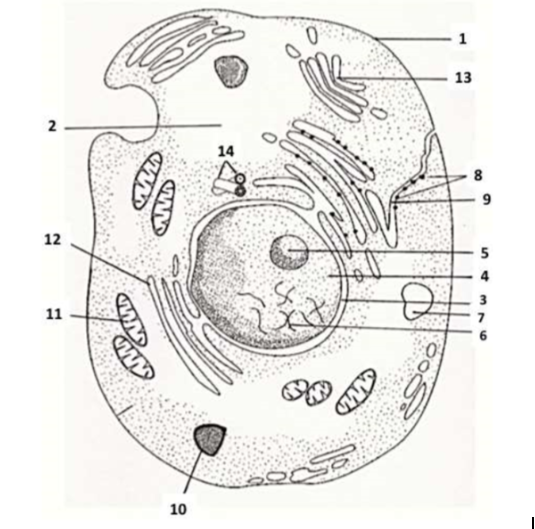
10?
lysosome
86
New cards
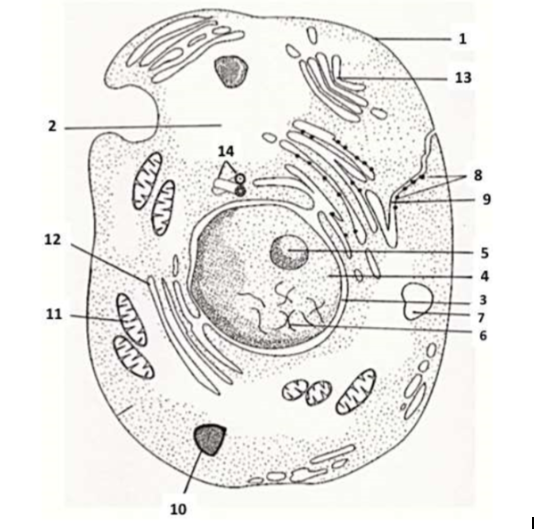
11?
mitochondria
87
New cards
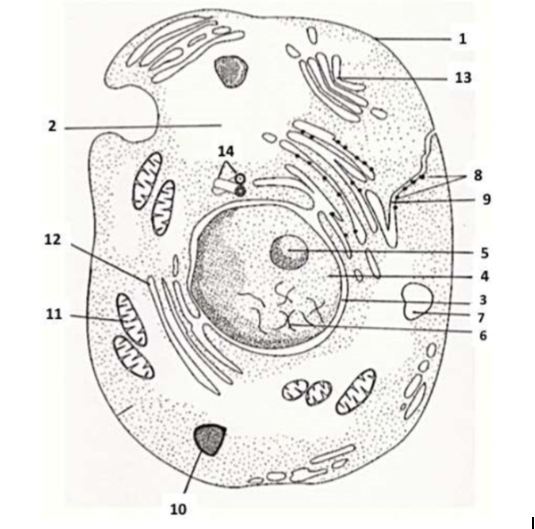
12?
smooth ER
88
New cards
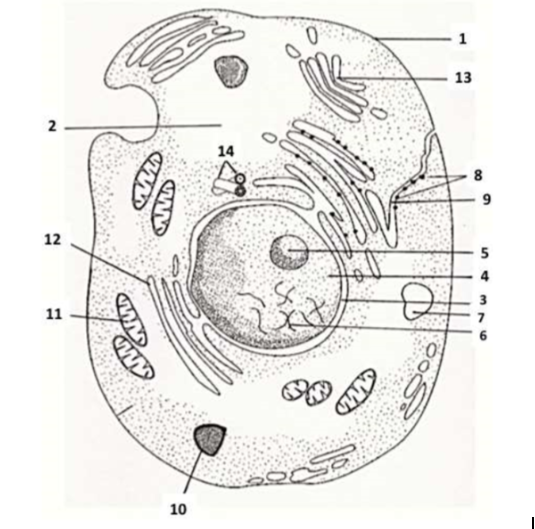
13?
golgi apparatus
89
New cards
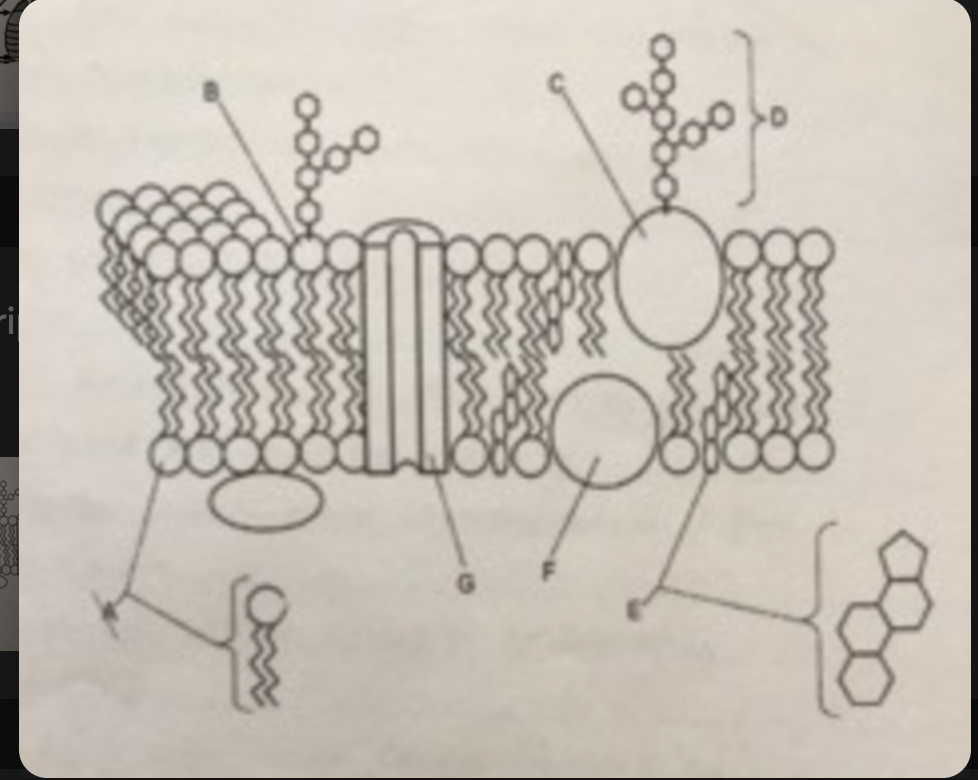
A?
phosopholipid
90
New cards
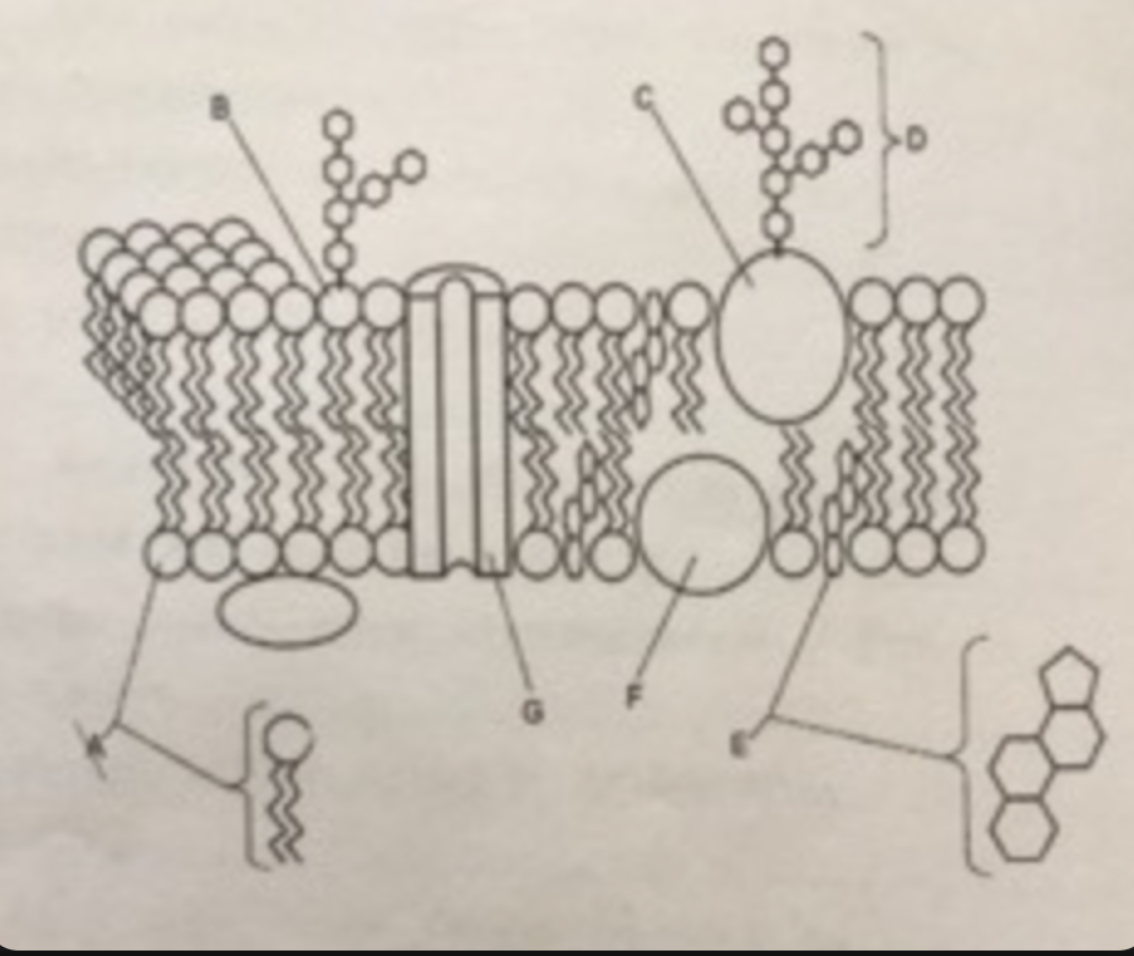
F?
peripheral protein
91
New cards
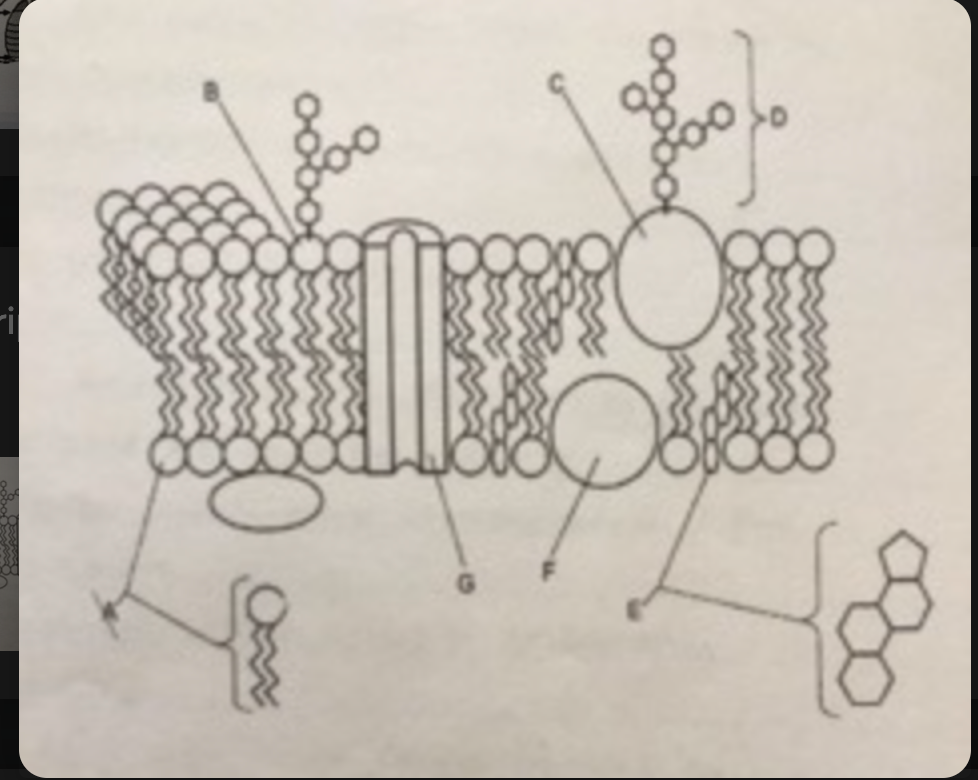
G?
integral protein
92
New cards
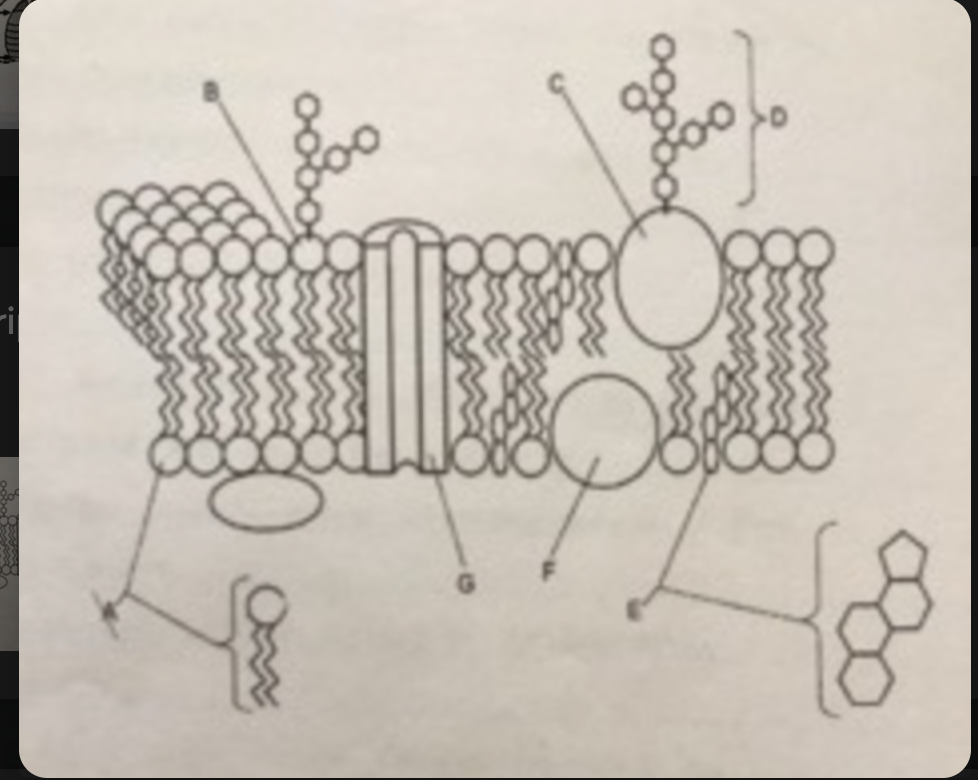
C?
glycoprotein
93
New cards
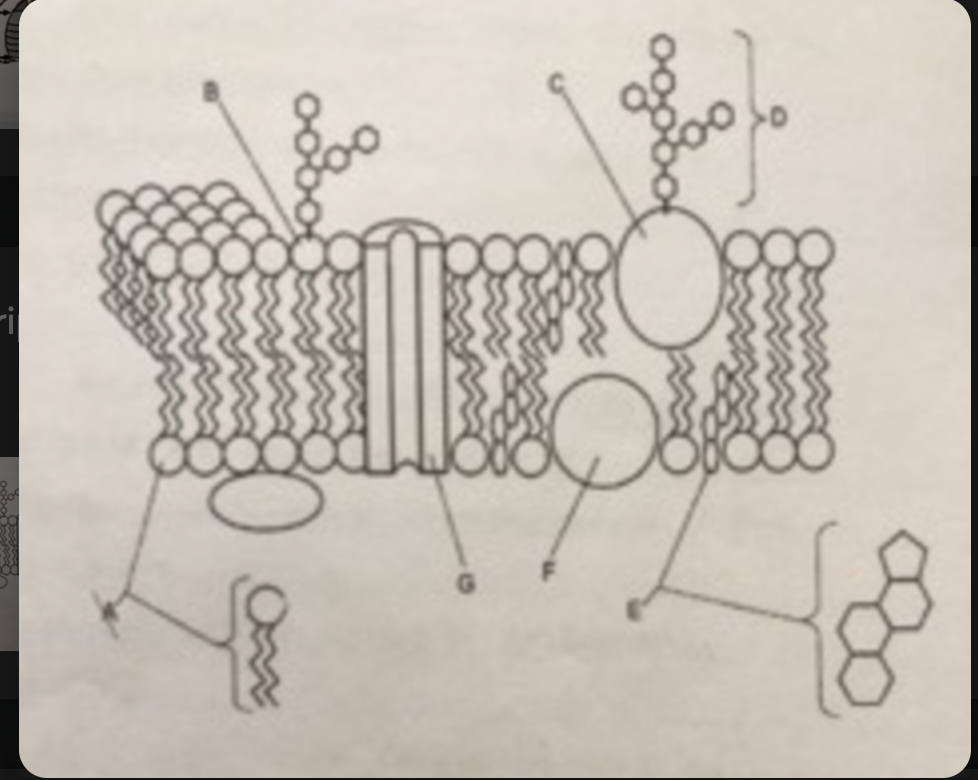
B?
glycolipid
94
New cards
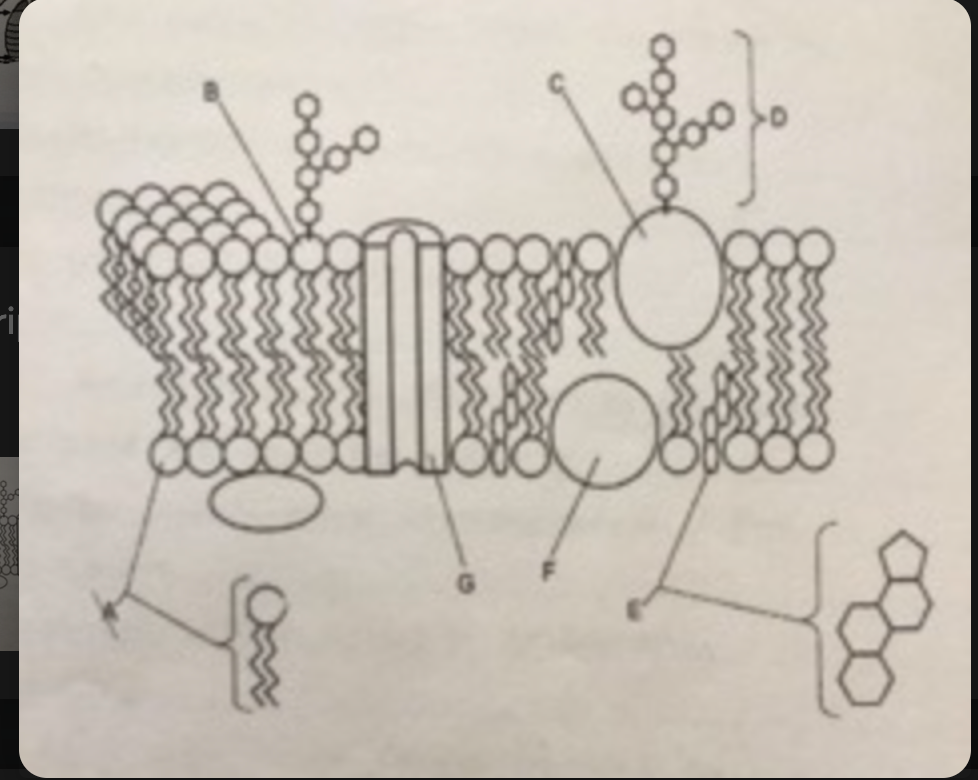
E?
cholesterol
95
New cards
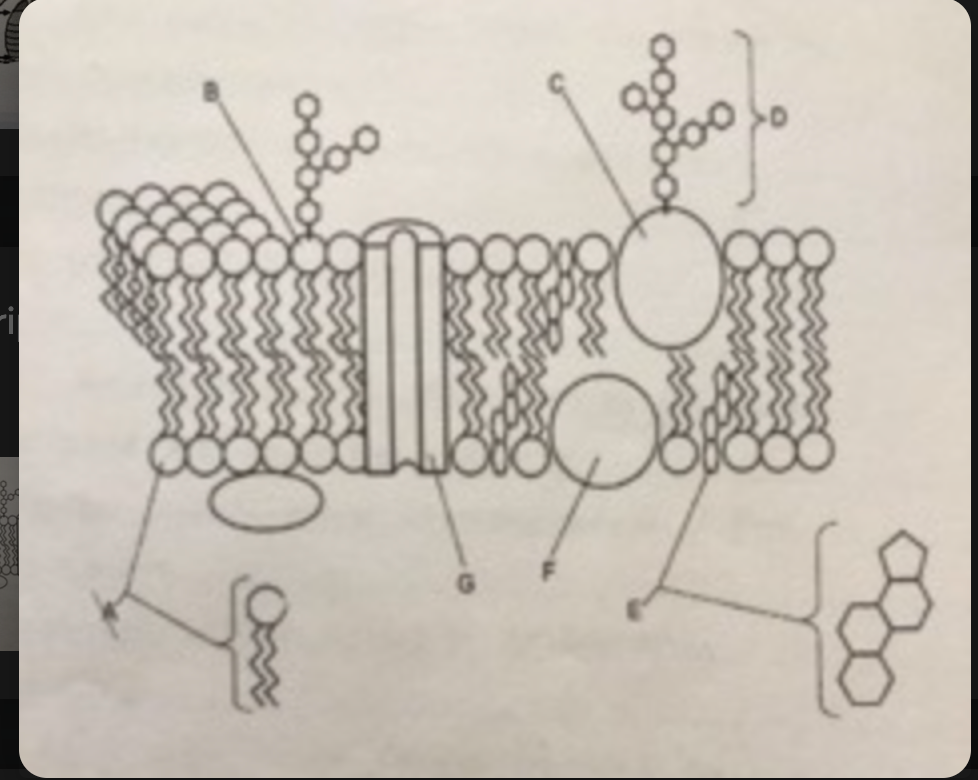
D?
carbohydrate
96
New cards
found on inside of membrane, connecting points for cytoskeleton, help to transmit signals from outside cell
peripheral protein
97
New cards
pass all the way through the membrane, serves as transmet channels or pumps
integral protein
98
New cards
acts as a waterproof barrier to protect the cell, hydrophilic head, hydrophobic tail, main component of the bilayer
phospholipid
99
New cards
attach to proteins
glycoprotein
100
New cards
attach to phospholipids
glycolipids